
Nicolas-Claude Fabri de Peiresc, often known simply as Peiresc, or by the Latin form of his name, Peirescius, was a French astronomer, antiquary and savant, who maintained a wide correspondence with scientists, and was a successful organizer of scientific inquiry. His research included a determination of the difference in longitude of various locations in Europe, around the Mediterranean, and in North Africa.

Persian Letters is a literary work, published in 1721, by Charles de Secondat, baron de Montesquieu, recounting the experiences of two fictional Persian noblemen, Uzbek and Reza, who are traveling through France.

Victor de Riqueti, Marquis de Mirabeau was a French economist of the Physiocratic school. He was the father of Honoré, Comte de Mirabeau and André Boniface Louis Riqueti de Mirabeau. He was, in distinction, often referred to as the elder Mirabeau as he had a younger brother, Jean-Antoine Riqueti de Mirabeau (1717–1794).
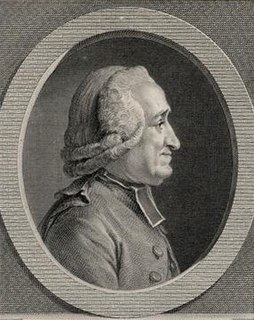
Jean-Jacques Barthélemy was a French scholar who became the first person to decipher an extinct language. He deciphered the Palmyrene alphabet in 1754 and the Phoenician alphabet in 1758.

Jean-Baptiste de Boyer, Marquis d'Argens (1703–1771) was a French rationalist, author and critic of the Catholic church, who was a close friend of Voltaire and spent much of his life in exile at the court of Frederick the Great.
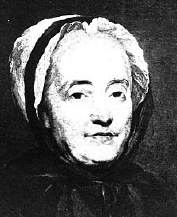
Françoise de Graffigny, better known as Madame de Graffigny, was a French novelist, playwright and salon hostess.

Shmuel Trigano is a sociologist, philosopher, professor emeritus of sociology at Paris Nanterre University. He was Tikvah Fund Visiting Professor in Jewish Law and Thought at Benjamin N. Cardozo School of Law, New York (2009), and Templeton Fellow at the Herzl Institute (Jerusalem) program "Philosophy of the Tanakh, Midrash and Talmud" (2012-2013), (2015-2017). Elia Benamozegh European Chair of Sephardic Studies, Livorno, Italy (2002).

David-Louis, Baron de Constant de Rebecque, seigneur d'Hermenches and Villars-Mendraz, a.k.a. David-Louis Constant d'Hermenches was a colonel and commandant of a Swiss regiment in the Dutch Republic and Maréchal de camp in French service with Swiss regiments. He is also known for his contact with Voltaire and his correspondence with Isabelle de Charrière.
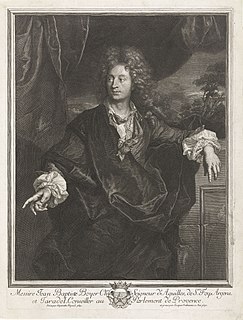
Jean-Baptiste Boyer, Marquis d'Éguilles (1650–1709) was a French aristocrat, lawyer and engraver.
Jean de Pauly was the translator of French editions of the portions of the Talmud and the first complete translation of the Zohar. He sometimes signed his works "Pavly." Born in Albania, he earned his doctorat ès lettres in Palermo, then lived at Basel, Lyon, where he appears to have been a teacher at the School of the Sacred Heart, then Rome, Orleans, Turin, before returning to die in poverty in Lyon. In his last years he was occupied with the translation of the Zohar, proposed to Pauly by France's biggest paper manufacturer, the Catholic Émile Lafuma-Giraud, and published 1906-11. His Zohar translation was criticised by Gershom Scholem for falsifying the book’s content.
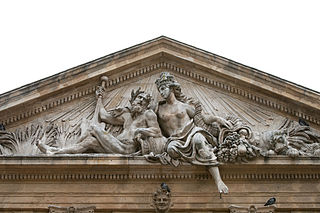
Jean-Pancrace Chastel (1726-1793) was a French sculptor.
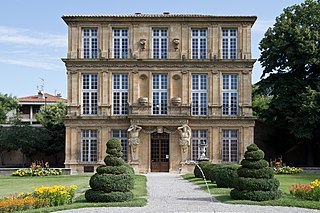
The Pavillon Vendôme is a historic pavilion surrounded by a French formal garden located 32 rue Celony in Aix-en-Provence, France.

Gaston de Saporta was a French aristocrat, palaeobotanist and non-fiction writer.
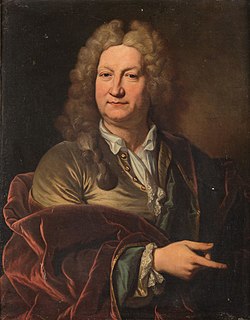
Honoré Boyer de Fonscolombe (1683–1743) was a French aristocrat, lawyer and public official.

The Bibliothèque Méjanes is the municipal public library of Aix-en-Provence, France. Inaugurated on 16 November 1810 as a part of the Aix-en-Provence City Hall, the library moved into a former match factory in 1989. Since 1993, the library has served as the center of the Cité du Livre, which joins together the expansive library, a screening room for independent films, and numerous rooms and workspaces for events. It also houses the Fondation Saint-John Perse and the Association des amis de Jules Isaac.
Led first by Philippe Pétain, the Vichy regime that replaced the French Third Republic in 1940 chose the path of collaboration with the Nazi occupiers. This policy included the Bousquet-Oberg accords of July 1942 that formalized the collaboration of the French police with the German police. This collaboration was manifested in particular by anti-Semitic measures taken by the Vichy government, and by its active participation in the genocide.

Father Jean-Paul de Rome d'Ardène in domaine d'Ardène in Saint-Michel was an 18th-century French botanist.

Esther Benbassa is a French-Turkish-Israeli historian and politician. She is the author of many books of Jewish studies. She serves as a member of the French Senate, where she represents Paris. After several reports in the French press accusing her of bullying several of her parliamentarian assistants and trainees, in September 2021 Esther Benbassa was excluded from her group, the Greens, where she was a Vice-president.

Alexandre Jean-Baptiste de Boyer, Marquis d’Éguilles was a French administrator who served as an unofficial envoy to Charles Edward Stuart during the 1745 Jacobite Rebellion. Taken prisoner after the Battle of Culloden in April 1746, he was released in 1747 and later held a senior legal post in the Provencal Regional Parliament. He was exiled from France in 1763 for opposing the suppression of the Jesuits but allowed to return in 1768 and died at home in March 1783.
Theodosius of Arles, was Archbishop of Arles c. 632–650.


















